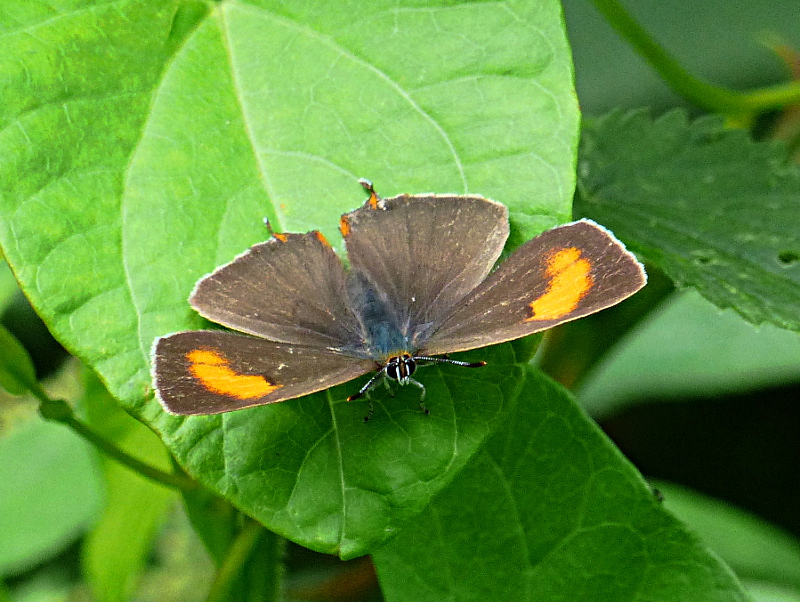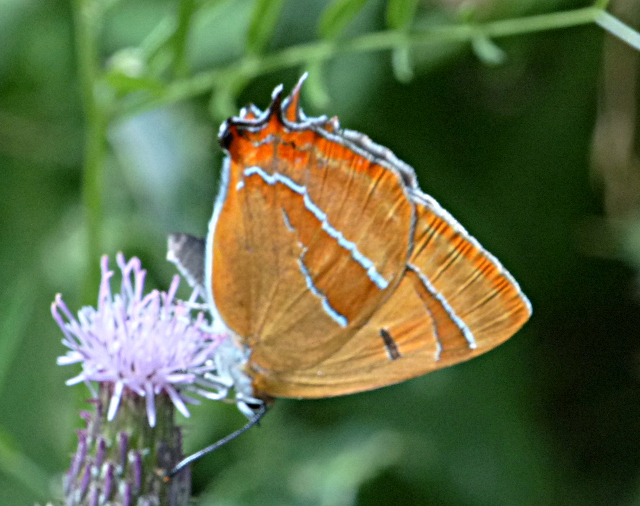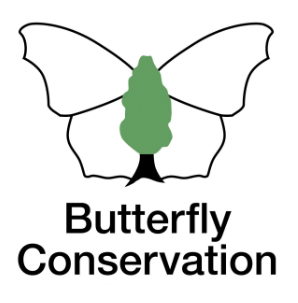Brown Argus
Brown Hairstreak
Chalkhill Blue
Clouded Yellow
Comma
Common Blue
Dark Green Fritillary
Dingy Skipper
Essex Skipper
Gatekeeper
Green Hairstreak
Green-veined White
Grizzled Skipper
Holly Blue
Large Skipper
Large White
Marbled White
Meadow Brown
Orange-tip
Painted Lady
Peacock
Purple Emperor
Purple Hairstreak
Red Admiral
Ringlet
Silver-washed Fritillary
Small Blue
Small Copper
Small Heath
Small Skipper
Small Tortoiseshell
Small White
Speckled Wood
Wall
White Admiral
White-letter Hairstreak
Extinct/rare immigrants
Brown Hairstreak
Thecla betulae
General Distribution and Status
This is our largest hairstreak where it occurs locally in south and west England and Wales. Colonies can extend at low densities over two or even four 10 km squares (Heath et al.). Many colonies were lost during the 20th century through removal of hedgerows especially after the Second World War. Numbers are still declining today because of annual mechanical trimming of hedgerows in many places; since 1976 its range has been reduced by half although since 2005 some of it has been regained (Fox et al.) perhaps because of increased searching for the butterfly's eggs. There are signs that the butterfly could be expanding north and east: an egg was found in the Richmond area in December 2016 and females observed egg-laying near Ipswich in Suffolk in 2016, apparently the first records in this county for over 50 years (Suffolk branch of Butterfly Conservation). In 2017, Liz Goodyear and Andrew Middleton found some eggs in the London boroughs of Hounslow and Richmond in November which suggests probable further expansion (Wood, 2018). In subsequent years, more adults and eggs were found in the Hillingdon area, including Ickenham Marsh and as far north as Whitewebbs Park confirming the expansion. New colonies discovered further north in Middlesex and finally in Hertfordshire in early 2024 when Rohan Harris found eggs at Merry Hill, near Bushey.
| United Kingdom | Herts & Middx | |||
| Distribution | 1976-2019 | -0.3% | 1980-2015 | n/a |
| Average 10-year trend | -0.1% | 2006-2015 | n/a | |
| 2024 since 2015-19 | +9% | |||
| Abundance | 1976-2024 | -9% | 1980-2015 | n/a |
| 2015-2024 | +13% | 2006-2015 | n/a | |
| 2023-2024 | +26% | 2024 since 2015-19 | * | |
UK distribution map
UKBMS Species summary
Habitat Requirements
Woodlands and hedgerows containing blackthorn are required for this elusive butterfly to breed.
Larval Foodplants
Blackthorn Prunus spinosa. In some parts of the country, other Prunus plants may be used. In Sussex, for example, Bullace (damson) Prunus domestica var. nigra and other ornamental plums are sometimes used (Blencowe & Hulme).
Adult Food Sources
Bramble Rubus fruticosis agg. (17), Honey-dew (8), Thistles Cirsium sp. (6), Common Fleabane Pulicaria dysenterica (5).
Historical Records
Gibbs in his 1902 report notes that Herbert Matthews captured some Brown Hairstreaks at Norton Green Woods during the late 1890s but the butterfly was not common there. No other locality in Hertfordshire was mentioned. The next report came from Tom Gladwin who saw one at Norton Green on 21 October 1971 (Bell). There is a doubtful record for a sighting in the Pirton area in 1978 (Waterton), most probably in or near Tingley Wood.
Local Distribution and Abundance
No confirmed sightings have been made in the Stevenage area although I have made a concerted effort in the last few years at Norton Green where a possible specimen was seen feeding on elderberry on 4 September 2012 by Andrew Wood and myself. However, photographic evidence was inconclusive. Another possible specimen was seen on the same day high up on an ash tree nearby but again there is some doubt about its identity. An egg hunt was carried out in the following winter at the site but no eggs were found.
In each subsequent year, I visited the site several times just to look for the butterfly in the early morning in August and early September; more specifically, on the ash tree about 30 metres west of the track. A female was seen basking on a leaf on the tree on 18 August 2013 and a male on 15 August 2015, also basking lower down on this tree. Although the two sightings using binoculars and a scope are promising, without confirmation by a good photograph, by anyone else finding the butterfly, or eggs being found on the site these sightings cannot be accepted. In addition, I have noted several orange-brown butterflies in flight at varying heights on the ash which might be indicative of Brown Hairstreaks considering their size and flight behaviour as well but see below for possible confusion with Purple Hairstreaks. Curiously, since 2020 I have not even seen possible Brown Hairstreaks at the site so could this mean that the butterflies were there previously?
There are three points to consider. Firstly, several Brown Hairstreak adults were released onto the site, on the blackthorn hedge south-west of Watery Grove in 2002. Is it possible that some of the progeny of these larvae have survived to the present day? Secondly, in the distant past, the site was apparently the only locality for the butterfly in Hertfordshire. The habitat seemingly still looks suitable with ample blackthorn bushes and tall woodland. Thirdly, there is a theory that larvae are at risk from pheasants (Corke), which are common around Watery Grove, but there is no known evidence cited for larvae predation from these game birds.
Some excitement came from Pottersheath just four miles south of Norton Green on 16 July 2017 when Sue Stephens found a female specimen basking on a Spiraea japonica leaf in a neighbour's garden. There were other reports of one on a tall birch tree by the A1(M) in the area. There is plenty of blackthorn close by as well as some other Prunus shrubs which could support colonies. Egg-hunts in the winter have not confirmed such populations. In addition, I probably saw a female specimen fly close to the ground as if on a mission towards the bramble/blackthorn hedge at the north-western tip of Knebworth Park on 19 September 2017. Richard Roebuck spoke about this behaviour occuring on the South Downs (Danahar). On 7 September 2018, a possible specimen was seen in the Rabley Heath area.
Life History
Male adults start emerging in late July but it is usually in the middle of August for females. The white eggs can be searched throughout the winter on the
foodplant before they hatch in spring. The green larvae feed at night and rest on the underside of a leaf by day. When fully grown, they will descend to the ground
to pupate.
More details on the UK Butterflies website
Behaviour/Observation notes
The Brown Hairstreak is a very secretive butterfly and is therefore difficult to find so many organisations are now using egg-hunts to monitor populations as the white eggs are far easier to locate once it is known where they are likely to be. The females tend to stick to the same egg-laying sites year by year, selecting sunny and sheltered spots and usually lay eggs singly on blackthorn twigs of one or two years' growth at varying heights in the early to mid afternoon. Males, on the other hand, hold territories high up in the tree canopy, usually around a tall ash tree. Middleton and Goodyear discovered that male territorial activity can start very early in the morning, before 09:00 hours, if the weather is favourable; light winds and some sunshine. Apart from chasing off intruders, they search for virgin or receptive females. After mating has taken place, females remain in the tree canopy until the eggs have matured after a few days when they will descend to locate suitable blackthorn bushes. Males usually stay confined to the tree canopy where aphid honeydew is used for food. Because of the females' egg-laying and feeding habits, they are the easier sex to find and are more likely to be seen during late morning and early afternoon.
From a distance, Brown Hairstreaks could be confused with Purple Hairstreaks in flight for inexperienced observers. Some worn Purple Hairstreaks might lose
their 'silvery' shine when the sun catches them and can appear more 'orangey' hence the confusion. One point to consider is the wing-shape but only to corroborate
other evidence. Purple Hairstreak wings have a slightly more rounded shape than those of its cousin so taking a photograph of these butterflies in flight may
help to distinguish between the two species.
Find out more on the UK Butterflies website
References
Bell, P. (1972). Macrolepidoptera in 1971, Transactions of the Hertfordshire Natural History Society, Vol 27 pp. 207-208

RSPB Otmoor 19 Aug 2019 (f)

Bookham Commons 4 Aug 2017 (m)

Bookham Commons 4 Aug 2017 (f)



